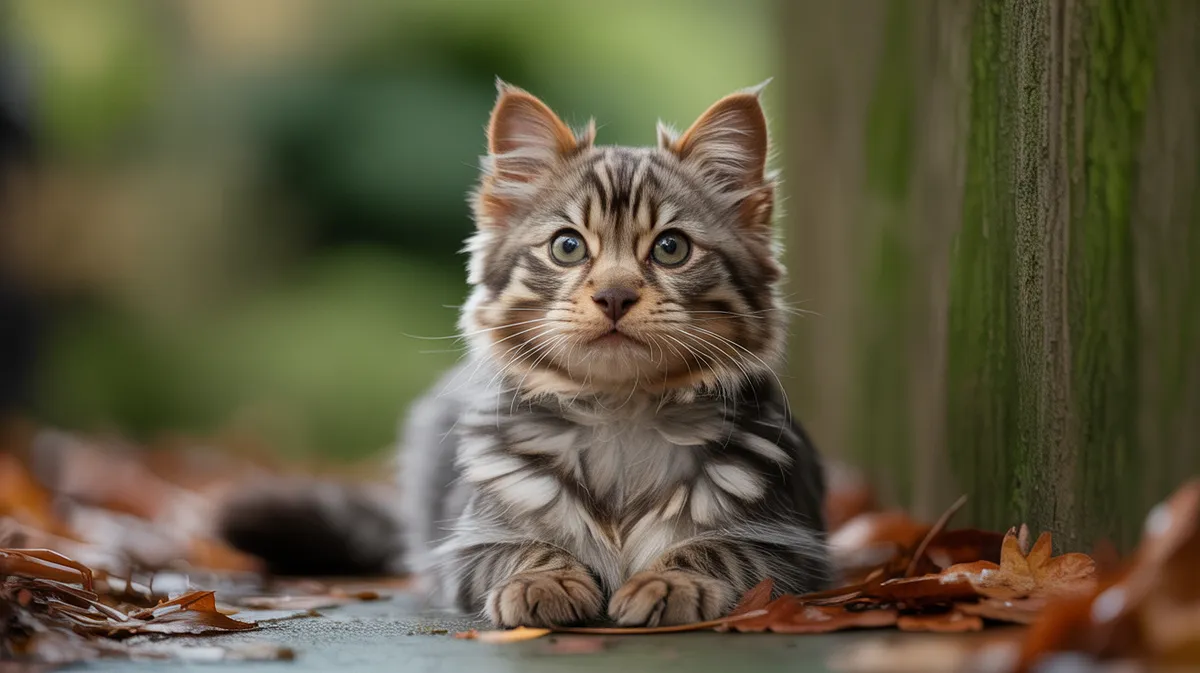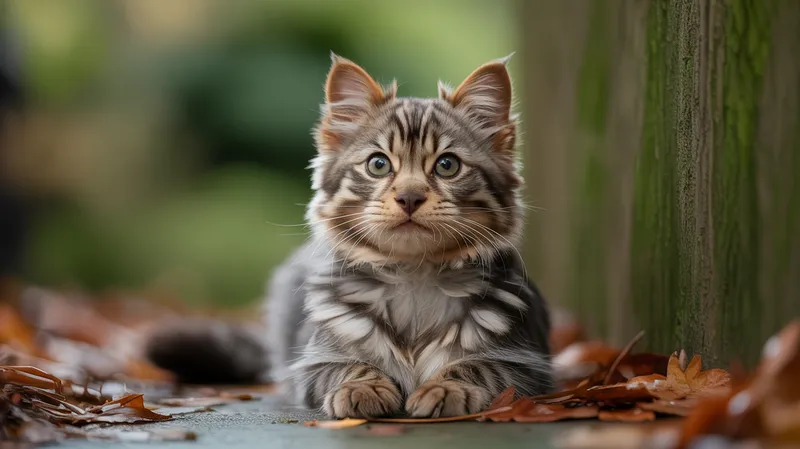
York Chocolate
Felis catus

Meet the York Chocolate
The York Chocolate is a rare domestic cat breed developed in the United States in the 1980s, recognized for its luxurious, semi-long, chocolate-brown or lavender coat. With a gentle and affectionate temperament, York Chocolates are known for being sociable, intelligent, and playful, making them excellent companions for families. Their plush fur is soft, water-resistant, and requires regular grooming to maintain its beauty. Although they are adaptable and thrive in indoor environments, their active nature means they enjoy interactive play and stimulation. The breed is now considered extremely rare due to a lack of active breeding programs.
Classification
Mammal
Habitat
Domestic
Diet
Carnivore
Lifespan
13-15 years
Conservation
Not Evaluated
Weight
4-7 kg
📖Fascinating Facts
Unique Coat Color
York Chocolates are distinguished by their rich chocolate or lavender-colored semi-longhaired coats, a rarity among domestic cats.
Origin Story
The breed originated from a farm in New York state in 1983, bred from a mix of domestic long-haired cats with chocolate coloring.
Personality Traits
Known for being affectionate, social, and playful, York Chocolates often form strong bonds with their human families.
📋Detailed Description
The York Chocolate is a medium-to-large domestic cat breed, typically weighing between 4.5 and 7 kg (10–15 lbs), with females generally smaller than males. Its most distinctive feature is a semi-long, dense, and water-resistant coat, predominantly in rich chocolate-brown or the dilute lavender (a pale, silvery brown), sometimes with white markings. The fur is notably soft, with a fine undercoat and a slightly longer ruff around the neck and breeches on the hind legs. The body is muscular yet elegant, with a slightly elongated, tapering tail and rounded paws. The head is wedge-shaped with a gentle contour, large almond-shaped eyes (often gold or green), and medium-sized, slightly forward-tilted ears. York Chocolates are renowned for their affectionate, people-oriented temperament, often seeking close contact with family members and displaying strong loyalty. They are intelligent, curious, and playful, retaining kitten-like behaviors well into adulthood. Socially, they tend to form strong bonds with both humans and other pets, and are known for their gentle, non-aggressive demeanor. Their vocalizations are soft and infrequent, relying more on body language to communicate. Despite their rarity, York Chocolates are robust and generally healthy, with a lifespan of 13–15 years when well cared for.
💡 Did you know?
Despite its appealing traits, the York Chocolate is not recognized by major international cat registries and is considered nearly extinct as an official breed.
🔬Research & Sources
Wikipedia Summary
The York Chocolate is an uncommon American breed of show cat, with a long, fluffy coat and a tapered tail and most of them were mostly or entirely chocolate-brown or the dilute form of brown, known as lavender. The breed was named after New York state, where it was established in 1983. This breed was created by color-selecting domestic long-haired cats of mixed ancestry. The breed is not widely recognized by cat registries. It is not recognized by the major organizations such as The International Cat Association (TICA), the Cat Fanciers' Association or Fédération Internationale Féline.
Last Modified: 5/26/2025
🎭Behavior & Social Structure
York Chocolates exhibit a blend of playful energy and calm affection. They are highly interactive, often following their owners from room to room and engaging in gentle play, such as chasing toys or participating in fetch-like games. Their intelligence is evident in their ability to learn tricks, solve food puzzles, and adapt to household routines. Unlike some breeds, they are not prone to destructive behavior when left alone, but they do thrive on companionship and mental stimulation. Hunting instincts persist, and they may stalk or pounce on moving objects, though their indoor lifestyle limits actual predatory behavior. Socially, they are tolerant of other cats and even dogs, integrating well into multi-pet households. Grooming is a self-maintained activity, but they also enjoy being brushed, which strengthens the human-animal bond. York Chocolates are crepuscular, showing peak activity at dawn and dusk, but adjust their routines to match their human families.
👶Reproduction & Life Cycle
York Chocolate cats reach sexual maturity at around 6–9 months. Breeding practices historically followed those of other domestic long-haired cats, with no known breed-specific reproductive anomalies. The estrus cycle in females occurs every 2–3 weeks during breeding season (typically spring and summer in temperate climates). After successful mating, gestation lasts approximately 63–65 days. Litters average 3–6 kittens, which are born blind and helpless. Queens exhibit attentive maternal care, nursing and grooming the kittens for the first 8–10 weeks. Kittens begin to wean at 4–5 weeks and are fully independent by 12–14 weeks. Due to the breed's rarity and lack of formal breeding programs, most York Chocolates today are neutered pets, and active breeding is virtually nonexistent.
🛡️Adaptations & Survival
The York Chocolate's semi-long, water-resistant coat is an adaptation to cooler climates, providing insulation and protection against moisture. The dense undercoat and longer guard hairs help maintain body temperature and repel water, a trait inherited from its mixed long-haired ancestry. Their muscular build and agile limbs enable adept climbing and jumping, while retractable claws and sensitive whiskers aid in navigation and prey capture. Behaviorally, their sociable nature and adaptability to indoor environments are evolutionary responses to domestication, favoring traits that foster close human-animal relationships. Their low vocalization and reliance on body language may be an adaptation to close-quarters living, reducing stress in multi-pet households.
📚Research Sources
🎨Cultural Significance
While the York Chocolate does not have a long history or deep-rooted cultural symbolism, it represents a modern effort to develop an American cat breed with unique coloration and temperament. Its name honors New York State, reflecting regional pride. The breed has occasionally appeared in cat shows and pet publications, symbolizing the diversity of domestic cats and the creativity of breeders. However, due to its rarity and lack of widespread recognition, it has not achieved significant cultural prominence or been featured in folklore, mythology, or traditional practices.
🔬Recent Research & Discoveries
Scientific literature on the York Chocolate is limited, with most information derived from breed standards, breeder accounts, and anecdotal reports. No peer-reviewed genetic studies have been published specifically on this breed, though broader research on domestic cat genetics provides context for its coat coloration and temperament traits. The breed's development through color selection of mixed long-haired cats aligns with known mechanisms of feline coat color inheritance, particularly the role of the brown (b) and dilution (d) genes. Recent interest in rare and heritage cat breeds has prompted calls for genetic preservation and documentation, but as of 2024, no formal conservation or research initiatives are underway for the York Chocolate.
🎥Wildlife Videos

African Safari Virtual Field Trip
www.virtualfieldtrips.org Enjoy an African Safari to Etosha in Namibia, Africa. Take a front row seat at the waterholes and see all ...
VirtualFieldTripsnet

Lions 360° | National Geographic
Growing up is a struggle, especially if you're a young male lion. In this VR film by National Geographic Explorer Martin Edström, ...
National Geographic

If This Didn’t Get Caught on Camera, Nobody Would Believe It
There are so many amazing and mysterious things in the world and it's so great that thanks to modern technology, we can see so ...
Wonders of the World

ZOOAmerica at HersheyPark || American Eagle, Armadillo +More North American Wildlife Habitat
Check out our other Hershey Park Videos HERSHEY CHOCOLATE WORLD Dining Options, World Largest Chocolate Store ...
MayandJC

Animals: Are they Conscious, or just Nature's Robots?
Welcome! Hippocampus here. Are animals conscious? It's a question we've all wondered for many years, including the scientific ...
Hippocampus
🌍Habitat Information
The York Chocolate typically inhabits Domestic environments. York Chocolates have adapted to their environments with specialized features and behaviors.
Primary Habitat:
Domestic
More detailed habitat information will be available soon.
🛡️Conservation Status
The York Chocolate is currently classified as Not Evaluated. Conservation efforts are crucial for preserving this species for future generations.
Common Threats:
- 🏠Habitat loss and fragmentation
- 🌡️Climate change impacts
- 🎯Hunting and poaching
- 🏭Human-wildlife conflict
⚠️Threats & Conservation Challenges
The primary threat facing the York Chocolate is genetic bottlenecking and loss of breed identity due to the lack of active breeding programs and formal recognition by major cat registries. As a result, the population is extremely small and fragmented, with few, if any, purebred individuals remaining. There are no known wild populations, and all individuals are kept as domestic pets. The breed faces challenges from outcrossing, which dilutes distinctive traits, and from limited public awareness. There are no specific health threats unique to the breed, but the small gene pool may increase susceptibility to hereditary conditions if breeding were to resume. Conservation efforts are hampered by the absence of breed clubs or organized registries.
🔬Scientific Classification
Scientific Name
Felis catus
Classification Hierarchy
🔍 About Taxonomic Classification
Taxonomic classification is a hierarchical system used by scientists to classify and organize living organisms based on shared characteristics and evolutionary relationships.
The system moves from broad categories (Kingdom) to increasingly specific ones, with each animal's scientific name typically consisting of its Genus and species.
📝Community Notes
Share your observations and insights about the York Chocolate with our community of wildlife enthusiasts.
Join Our Community
Sign in to share your observations and connect with fellow wildlife enthusiasts.
Sign In to ContributeNo community notes yet
Be the first to share your observations about the York Chocolate!
Explore York Chocolate
Select a tab above to learn more about this amazing animal.
📸Photo Gallery
No photos available for this animal yet.
🌟Discover More Wildlife
Continue your journey of discovery with more fascinating animals from our database
